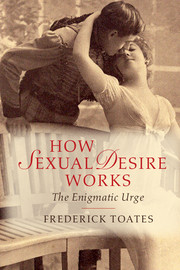Book contents
- Frontmatter
- Dedication
- Contents
- List of figures
- Preface
- One What is enigmatic about sexual desire?
- Two Explaining desire: multiple perspectives
- Three Sexual desire in a broad context
- Four An incentive-based model
- Five Sex and levels of organization
- Six Sexual attraction
- Seven Shades of desire from simple to complex
- Eight Details of the brain and desire
- Nine Arousal
- Ten The consequences of sexual behaviour and associated expectations
- Eleven Sexual familiarity and novelty
- Twelve Inhibition, conflict and temptation
- Thirteen How did sexual desire get here?
- Fourteen Setting the trajectory: link to adult sexuality
- Fifteen Sexual desire in interaction
- Sixteen Representations of sex
- Seventeen Sexual addiction
- Eighteen Variations in desire: general principles
- Nineteen Some forms of desire at the fringes
- Twenty The toxic fusion: violence and sexual desire
- Twenty one Sexually associated (serial) murder
- Twenty two Concluding remarks
- Notes
- References
- Index
Two - Explaining desire: multiple perspectives
Published online by Cambridge University Press: 05 October 2014
- Frontmatter
- Dedication
- Contents
- List of figures
- Preface
- One What is enigmatic about sexual desire?
- Two Explaining desire: multiple perspectives
- Three Sexual desire in a broad context
- Four An incentive-based model
- Five Sex and levels of organization
- Six Sexual attraction
- Seven Shades of desire from simple to complex
- Eight Details of the brain and desire
- Nine Arousal
- Ten The consequences of sexual behaviour and associated expectations
- Eleven Sexual familiarity and novelty
- Twelve Inhibition, conflict and temptation
- Thirteen How did sexual desire get here?
- Fourteen Setting the trajectory: link to adult sexuality
- Fifteen Sexual desire in interaction
- Sixteen Representations of sex
- Seventeen Sexual addiction
- Eighteen Variations in desire: general principles
- Nineteen Some forms of desire at the fringes
- Twenty The toxic fusion: violence and sexual desire
- Twenty one Sexually associated (serial) murder
- Twenty two Concluding remarks
- Notes
- References
- Index
Summary
The clashing point of two subjects, two disciplines, two cultures – of two galaxies, so far as that goes – ought to produce creative chances. In the history of mental activity that has been where some of the breakthroughs came.
(C. P. Snow, 1965, p. 16)This chapter looks at several types of explanation that can be applied to sexual desire and the links between them. It starts by considering desire in the here-and-now; that is, events in the mind and brain as individuals experience sexual desire. Some basic psychology and biology will then be introduced. The book suggests that we can gain insight by exploring similarities between sex and a number of other activities, for example feeding, gambling and drug-taking. The chapter then asks how the processes underlying sexual desire came into being. Two very different time scales will be considered: the evolutionary history of humans and the development of the individual.
The ‘here-and-now’: broad principles
The study of desire in the here-and-now is in terms of brains and minds, as well as such things as heart rate and blood flow to the genitals. Of course, desire is often triggered by the perception of an attractive person. This much would be obvious simply from talking to the one feeling the desire, quite apart from monitoring events in the body and observing behaviour. In the physical absence of an attractive other, representations of such an individual in the form of pictures or simply memories in the mind can trigger desire. Sensations arising in the genitals also contribute to desire and lock into interaction with the factors just described.
- Type
- Chapter
- Information
- How Sexual Desire WorksThe Enigmatic Urge, pp. 29 - 67Publisher: Cambridge University PressPrint publication year: 2014

